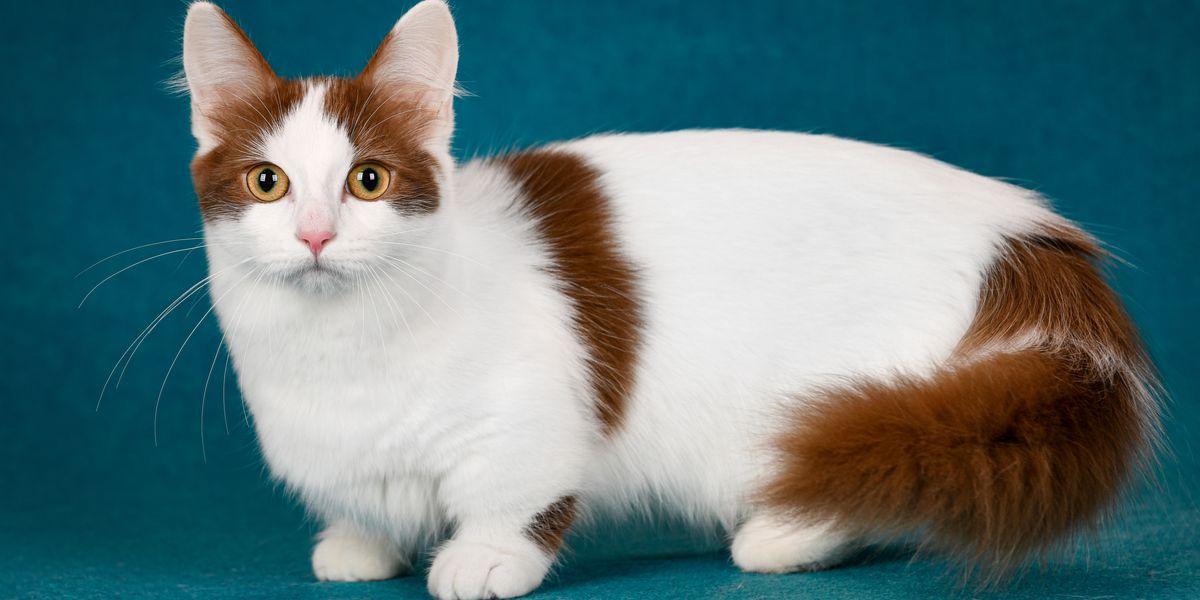
Cat breeds with short legs are surprising to see, and some cat lovers find them irresistibly adorable.
The condition that causes extremely short legs in cats is called chondrodystrophy, commonly known as dwarfism. Both the front legs and hind legs are affected.
Chondrodystrophy occurs due to an autosomal dominant gene that causes abnormal cartilage development, which in turn causes abnormal growth of the long bones. Animals with chondrodystrophy have abnormally short legs. Some dog breeds are affected by dwarfism, including the Basset Hound, Corgi, and Dachshund.
Dwarfism in cats is unusual and rare. Short legs are not advantageous for cats living in a natural environment as it hinders running and jumping, movements that are vital for hunting. Dwarfism occurs randomly and spontaneously via a genetic mutation in a kitten.
History of Dwarf Cat Breeds
Dwarfism in cat breeds is a relatively new phenomenon. The first dwarf breed was the Munchkin, which was formally recognized by The International Cat Association (TICA) in 2003.
Aside from the Munchkin, only one other dwarf cat breed is fully recognized by TICA—the Minuet (formerly called the Napoleon). The Minuet was created via crosses with Munchkin cats Persians, Himalayans, and Exotic Shorthairs. The Cat Fanciers Association (CFA) does not recognize any dwarf cat breeds.
A few other dwarf cat breeds under development are considered experimental, meaning they are not recognized for championship status by one of the mainstream cat registries (TICA or CFA). These breeds have been created by using the Munchkin and crossing it with various other purebred cats.
There is much debate about whether breeding dwarf cats is or is not an ethical practice. Some forms of dwarfism are connected with various health problems, and dwarf cats cannot move the same way that typical cats can.
Let’s take a look at the official and experimental cat breeds with short legs.
Official Dwarf Cat Breeds
#1 Munchkin
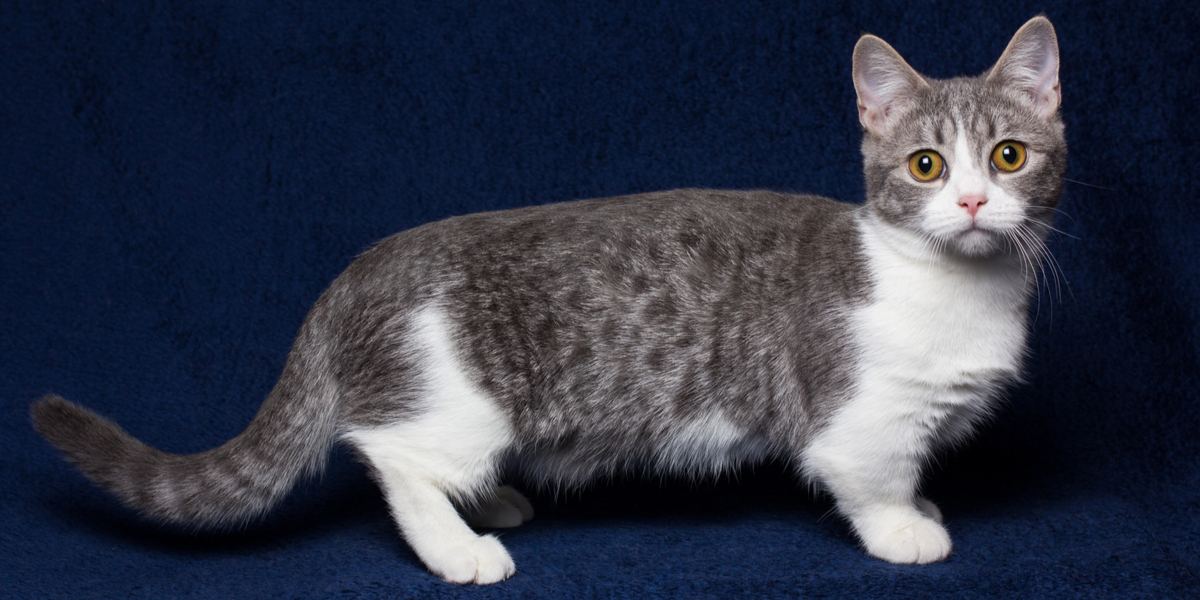
The original short-legged cat breed, the Munchkin, resulted from a spontaneous genetic mutation. In 1983, a woman from Louisiana named Sandra Hockenedel found a pregnant female cat with very short legs. Hockenedel named the cat Blackberry. When Blackberry gave birth, some of the kittens had short legs and some had long legs.
Hockenedel gave a male kitten named Toulouse from Blackberry’s first litter to her friend Kay LaFrance. The Munchkin breed was developed using Toulouse, Blackberry, and domestic cats of normal leg length to provide genetic diversity to the breed. The breed was named for the Munchkins that appear in the 1939 book The Wizard of Oz.
The Munchkin was accepted into TICA’s New Breed Development program in 1994, where it continued to be developed and observed. The Munchkin was awarded full championship status with TICA in 2003.
The Munchkin is sometimes called the “sausage cat” owing to its physique. Munchkins have either short hair or long hair and may be any color. Despite its short legs, the Munchkin is known for being very fast and its ability to turn on a dime. Munchkins are active, playful, curious, and extremely social.
The Munchkin cat breed is very healthy with no known health issues or spinal problems or spinal curvature related to its dwarfism. The Munchkin is not more affected by arthritis or mobility issues than any other breed.
#2 Minuet

Image Credit: https://www.pinterest.com/pin/599541769130699366/
Breed Overview
- ORIGIN: United States
- ADULT WEIGHT: 5-9 pounds (2.3-4 kg)
- GROUP: Small short-haired and long-haired
- HEIGHT: 5-8 inches (12.7-20 cm)
- LIFE SPAN: 12-15 years
- PRICE: $500-$3,000
The Minuet cat was created by crossing Munchkin cats with Persian cats, Himalayan cats, and Exotic Shorthairs. The breed founder, a U.S. man named Joe Smith, was originally a Basset Hound breeder. He worked with his mentor Deb Kenny, who was a Persian breeder.
The breed was originally called the Napoleon cat, but in 2015, TICA voted to officially change the breed name to Minuet. The breed achieved full championship status with TICA in 2016.
The Minuet cat comes in shorthaired and longhaired versions; both have an abundant and dense coat. The Minuet has a round head, round eyes, and small, round ears. These cats are gentle and sweet like the Persian, but also active and curious like the Munchkin. Minuets are very sociable and friendly and adore their people.
Experimental Dwarf Cat Breeds
Breeders have used the Munchkin to develop other new dwarf cat breeds. The breeds listed here are considered experimental, meaning they are not recognized for championship status by one of the mainstream cat registries (TICA or CFA).
These breeds are being developed by crossing the original dwarf cat breed, the Munchkin, with various other purebred cats.
#1 Bambino

Image Credit: https://www.hepper.com/bambino-cat-cost/
Breed Overview
- ORIGIN: United States
- ADULT WEIGHT: 5-9 pounds (2.3-4 kg)
- GROUP: Hairless
- HEIGHT: 7-8 inches (18-20 cm)
- LIFE SPAN: 9-14 years
- PRICE: $1,500-$3,500
The Bambino cat is a cross between Munchkin cats and Sphynx cats. As a result, the Bambino is a hairless, short-legged cat. The first Bambino cat litter was registered in the United States in 2005. This breed is very new and experimental.
#2 Dwelf

Breed Overview
- ORIGIN: United States
- ADULT WEIGHT: 4-9 pounds (1.8-4 kg)
- GROUP: Hairless
- HEIGHT: 6-7 inches (15-18 cm)
- LIFE SPAN: 12-15 years
- PRICE: $2,000-$3,500
Like the Bambino, the Dwelf cat is part Munchkin and part Sphynx, but a third breed is also included in the mix: the American Curl. As a result, the Dwelf is short-legged and hairless, with backward curled ears like the American Curl. The breed was first developed in the United States sometime after 2005 (when the first Bambino litter was registered).
#3 Genetta
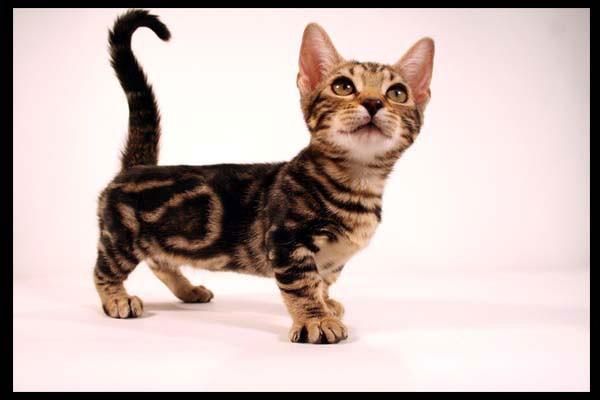
Image Credit: https://nl.pinterest.com/pin/313492824040329700/
Breed Overview
- ORIGIN: United States
- ADULT WEIGHT: 4-8 pounds (1.8-3.6 kg)
- GROUP: Small short-haired and long-haired
- HEIGHT: 7-8 inches (18-20 cm)
- LIFE SPAN: 12-16 years
- PRICE: $500-$5,000
Another breed created in the United States, the Genetta is the result of crosses between the Munchkin and Bengal. Genettas have short legs and spotted coats like the Bengal. Though intended to resemble a small South African wild animal called the genet (which is not actually a feline species), Genettas are 100% cat.
#4 Lambkin (Nanus Rex)
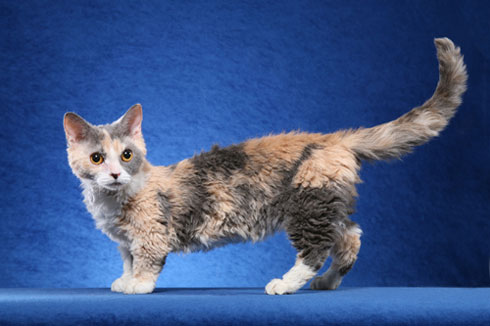
Image Credit: https://icatcare.org/advice/lambkin/
Breed Overview
- ORIGIN: United States
- ADULT WEIGHT: 5-9 pounds (2.3-4 kg)
- GROUP: Small short-haired and long-haired
- HEIGHT: 7-8 inches (18-20 cm)
- LIFE SPAN: 12-14 years
- PRICE: $1,500-$3,000
The Lambkin cat is the result of mixing the Munchkin with the curly-coated Selkirk Rex. Lambkins have the short legs of the Munchkin and the dense, curled coat of the Selkirk. Also known as the Nanus Rex, the Lambkin was first developed in the United States, possibly in the late 1980s or early 1990s.
#5 Minskin
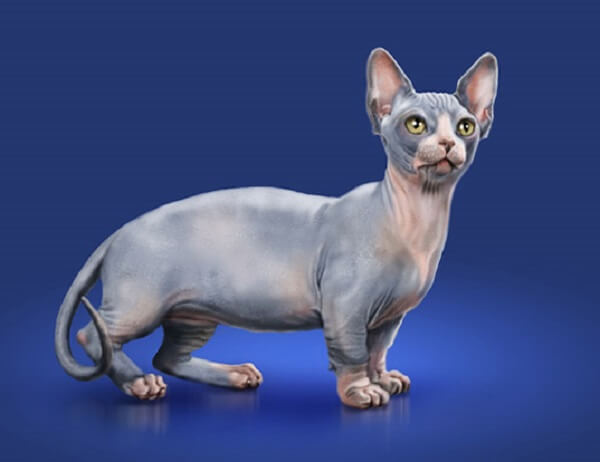
Image Credit: https://en.wikipedia.org/wiki/Minskin
Breed Overview
- ORIGIN: United States
- ADULT WEIGHT: 4-6 pounds (1.8-2.7 kg)
- GROUP: Hairless
- HEIGHT: 7-8 inches (18-20 cm)
- LIFE SPAN: 12-15 years
- PRICE: $1,500 – $5,000
The Minskin cat was created in Boston in the late ’90s by a cat breeder named Paul McSorley. The breed is the result of crossing the Munchkin with the Sphynx, Devon Rex, and Burmese. The Minskin is a short-legged, largely hairless cat with “fur points” (patches of fur on the head, legs and tail, similar to the color points found on a Siamese). The Minskin is designated as a Preliminary New Breed by TICA.
#6 Skookum
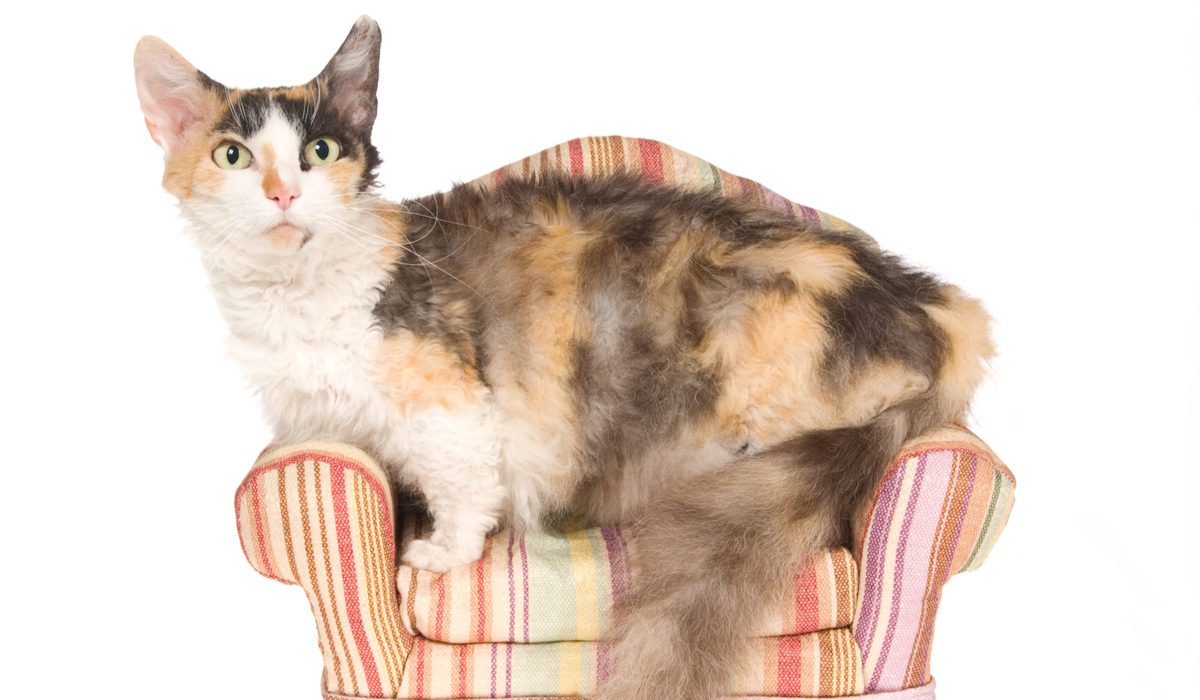
Breed Overview
- ORIGIN: United States
- ADULT WEIGHT: 3-7 pounds (1.4-3.2 kg)
- GROUP: Small short-haired and long-haired
- HEIGHT: 5-8 inches (12-20 cm)
- LIFE SPAN: 10-15 years
- PRICE: $500 – $3,000
Like the Lambkin, the Skookum is short-legged, curly-coated breed. Rather than inheriting its curly coat from the Selkirk Rex like the Lambkin, the Skookum was developed from crossbreeding between the Munchkin with the LaPerm. Once known as the LaMerm, the Skookum is designated as an Experimental New Breed with TICA.
Frequently Asked Questions:
What breeds of cat have short legs?
Two dwarf cat breeds are recognized by The International Cat Association (TICA): the Munchkin and the Minuet. A few other dwarf cat breeds are considered experimental. These are still in development and are not recognized for championship status by one of the mainstream cat registries (TICA or CFA). Some short-legged experimental cat breeds include the Dwelf, Genetta, Lambkin (Nanus Rex), Minskin, and Skookum.
Do some cats have short legs?
The condition that causes extremely short legs in cats is called chondrodystrophism or dwarfism. A few cat breeds have short legs, but mixed breed cats may also be born with chondrodystrophism. This occurs due to a spontaneous and random genetic mutation.
Why does my cat have short stubby legs?
Extremely short legs in cats is caused by a condition called chondrodystrophism, also known as dwarfism. Chondrodystrophy occurs due to an autosomal dominate gene that causes abnormal cartilage development, which in turn causes abnormal growth of the long bones. Animals with chondrodystrophy have abnormally short legs. Dwarfism occurs randomly and spontaneously via a genetic mutation in a kitten.



